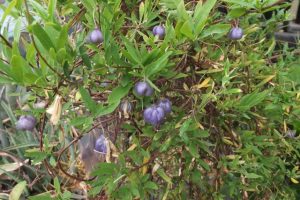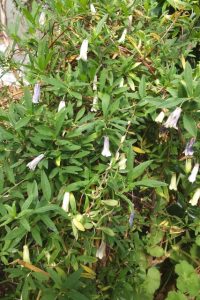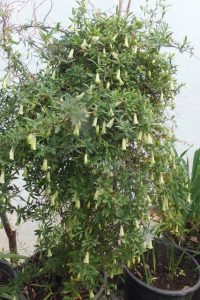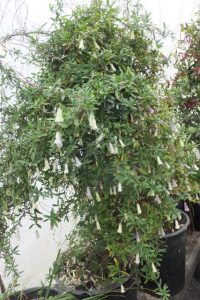
Be warned, these unique fruits may lure Blackbirds and Thrushes to venture into your greenhouse just to steal them. There is something about the colour, look or taste of these blue apple-berries that is irresistibly attractive to them. Which is odd as they are edible to us though not remarkably palatable, certainly not very more-ish and definitely not apple-like in any way other than possibly their shape.

Introduced from Tasmania at the beginning of the Nineteenth century Billardiera longiflora is one of a small genus of low growing Australasian evergreen climbers. Borderline hardy this has been successfully grown in very sheltered southern UK gardens but is much safer as a cool greenhouse or conservatory subject.

Although the berries are indeed attractive visually I doubt they’ll become a mainstay of your diet, shall we say more use as emergency bush-tucker. But the tubular flowers are so pretty, first opening white then slowly fading to a pale mauve purple. Moreover these bushy climbers bloom over a long period and not being aggressively vigorous make a pleasant change to many climbers staying constrained to a compact one maybe two metres.

Although growing from seed is quite straight forward I’d recommend you search for named varieties as these will be better quality and you can then root cuttings or layer stems for more plants. There are also white and red berried forms, I’ve considered potting together all three for a most curious, patriotic, effect.

Not Ericaceous as such Billardiera prefers moist mildly Acidic free draining compost, thus an Ericaceous compost is indicated though I find adding about a third leaf mould to loam based compost works fine. As with most potted plants rain water is preferable though tap water can be used, water well and regularly and with a little general purpose liquid feed throughout the growing season. Keep the compost just moist throughout the darker cooler months.

Named after a French botanist Billardiera was available to Victorian gardeners by the end of their era in eight species, rather surprisingly a half dozen are still listed.










